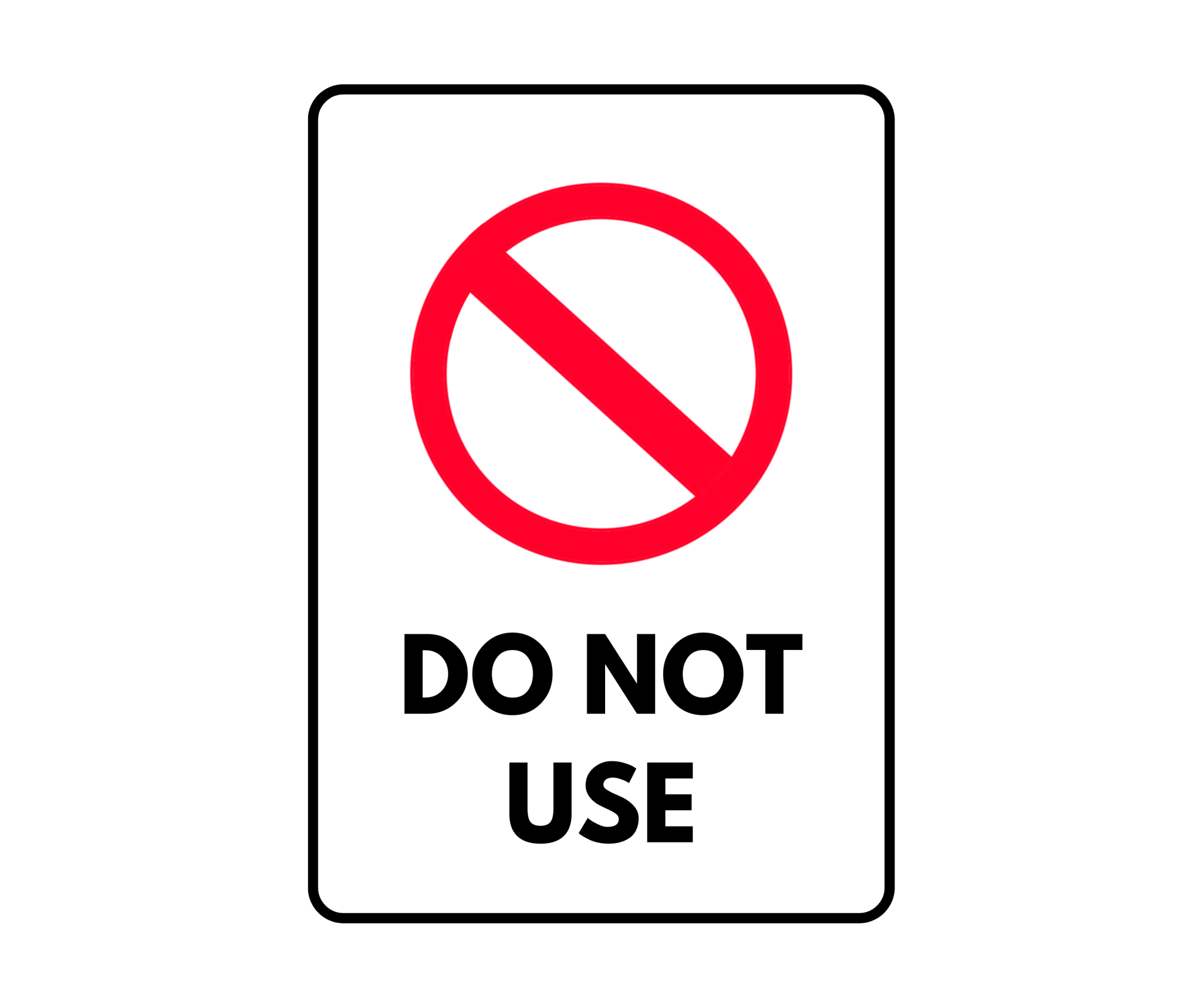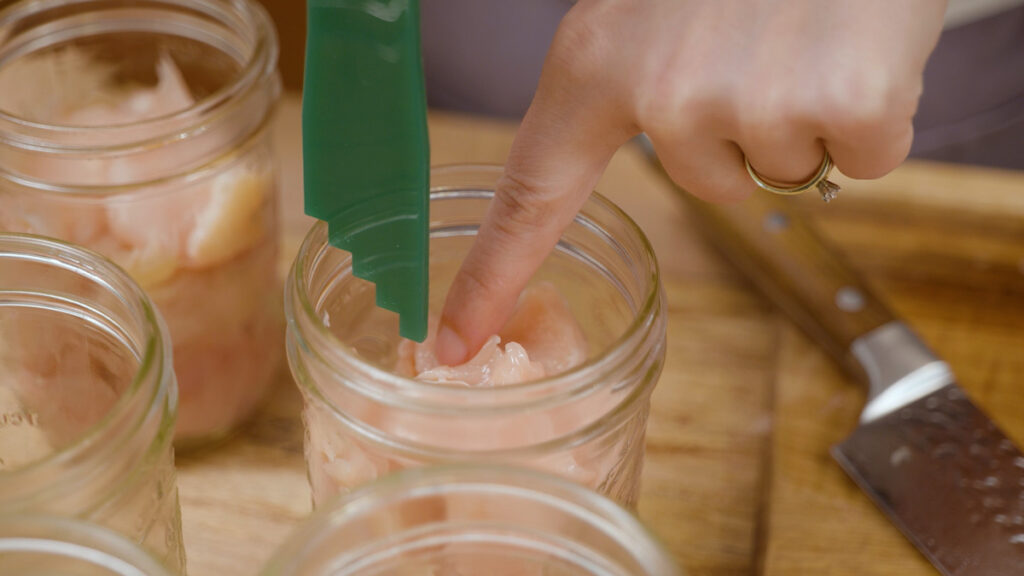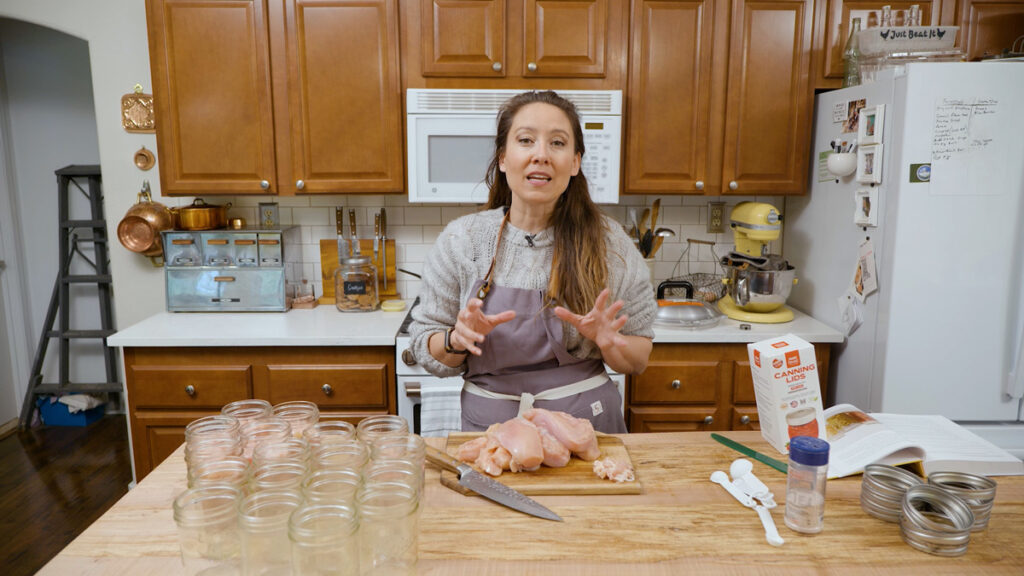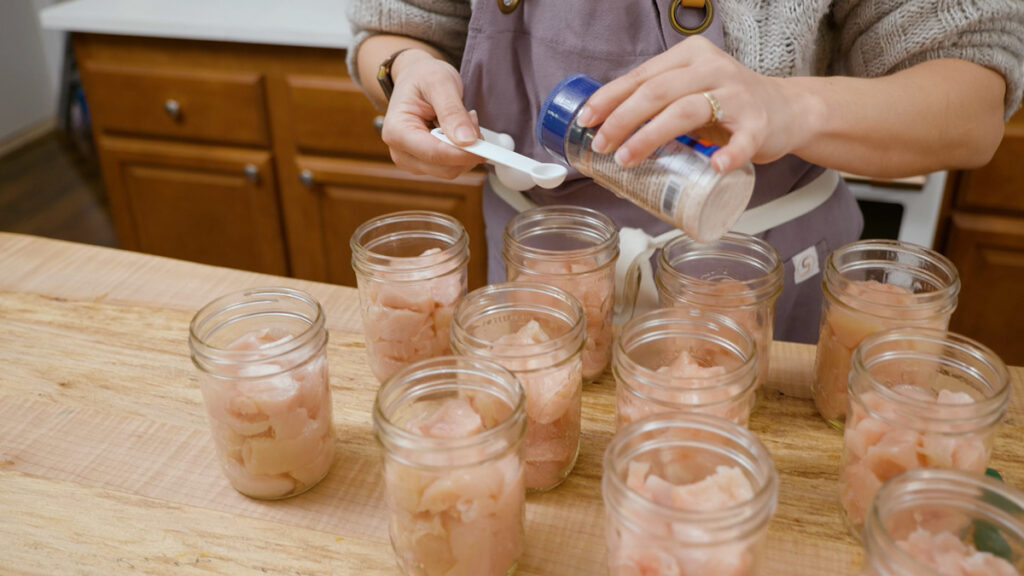Learn how to can chicken with this safe and easy method that requires zero cooking ahead of time. This is a great way to clear your freezers and create a delicious, shelf-stable canned chicken thats perfect for easy weeknight dinners.
Home canned chicken is a great way to keep meat for later use. When you keep canned chicken on hand, quick and easy meals are always close at hand. If you canned chicken, you can get the most out of the meat, whether you raised the chickens yourself or bought them at the store.
This step-by-step guide will walk you through the entire canning chicken process. You’ll learn everything you need to know to safely can chicken for your pantry.
Why Can Chicken?
There are several benefits to canning chicken at home:
-
Long shelf life—if you can chicken the right way, it will stay safe for one to five years. This means you can save meat from a bulk purchase or chickens you raised yourself.
-
Saves money – Buying chicken when it’s on sale and canning it saves money compared to buying fresh chicken weekly.
-
Convenience – No need to defrost meat! Canned chicken is ready-to-use, saving prep time.
-
There are many ways to use canned chicken. It can be used in soups, sandwiches, salads, casseroles, and more. It’s more versatile than freezing whole pieces.
-
Peace of mind – Home canned chicken provides food security. You’ll have meat on hand if you can’t get to the store.
Step 1: Get Equipment and Supplies
Canning chicken requires specific equipment to ensure safety. Here’s what you need:
- Pressure canner
- Canning jars with lids and bands (pint or quart-sized)
- Canning tools – jar lifter, funnel, bubble removal tool
- Large pot with lid for hot pack method
Don’t use a water bath canner for meat. Chicken must be pressure canned to kill bacteria and botulism spores.
Step 2: Prepare the Chicken
Raw Pack Method
Cut chicken into small, uniform pieces. If you want, take off the skin and bones. Pack the raw chicken into jars in a loose way.
Cover chicken with boiling water, broth, or juice, leaving 1 inch of headspace. The liquid helps chicken retain moisture during canning.
Hot Pack Method
In a large pot, simmer chicken pieces in water, broth, or juice until they are 2/3 done. Loosely pack hot chicken and cooking liquid into jars, leaving 1 inch of headspace.
Hot pack takes a little more work but helps remove air pockets and leads to better texture.
Step 3: Remove Air Bubbles and Clean Rims
Slide a bubble removal tool or non-metal utensil along the inside of the jar to release trapped air bubbles. Add more chicken or liquid if needed to maintain headspace.
Wipe jar rims with a clean, damp cloth to remove residue. Check for nicks or chips that could affect the seal.
Step 4: Apply Lids and Bands
Center lids on jar rims and screw on bands just fingertip tight. Over tightening can prevent air from venting during canning.
Step 5: Process Jars in a Pressure Canner
Place jar rack and 2-3 inches of water in the pressure canner. Load sealed jars onto the rack using a jar lifter. Fasten the lid according to the manufacturer’s instructions.
Turn burner to high and exhaust steam for 10 minutes before closing the petcock or placing the regulator. Let pressure rise until it reaches the required psi. Start timing when pressure is reached.
Process pint jars for 75 minutes and quart jars for 90 minutes at 10 psi. Increase time if you live over 1,000 ft above sea level.
When time is up, turn off heat. Allow canner to naturally depressurize 10 minutes before carefully opening the lid away from you.
Step 6: Cool and Store Canned Chicken
Use a jar lifter to transfer jars to a cooling rack, leaving 2 inches between jars. Avoid drafts.
Leave jars undisturbed for 12-24 hours. Check lid seals, then remove rings. Clean jar exteriors and label with content and date.
Store properly sealed jars in a cool, dark place. Let canned chicken sit a few weeks before use for best flavor. Refrigerate after opening.
Tips for Successful Canning
Follow these tips for safely canned chicken with the best color and texture:
-
Use fresh, high-quality meat – don’t can old chicken.
-
Chill chicken for 6-12 hours before canning raw pack.
-
Cut chicken into uniform pieces to ensure even heating.
-
Trim fat to limit floating pieces and seal issues.
-
Keep headspace consistent across jars for proper sealing.
-
Wipe rims thoroughly after filling jars.
-
Don’t over tighten bands or move jars once filled.
-
Vent pressure canner 10 minutes before pressurizing.
-
Let canner depressurize naturally; don’t rush the process.
Serving Canned Chicken
The mild flavor of canned chicken makes it endlessly versatile. Try it in these quick and easy dishes:
-
Chicken Salad – Dice and mix with mayo, celery, onion, and spices.
-
Chicken Tacos – Shred and season chicken with taco spices and topping.
-
Chicken Noodle Soup – Slice chicken and add to broth with veggies and noodles.
-
Chicken Casserole – Combine canned chicken with rice, veggies, and cream soup.
-
Chicken Enchiladas – Roll tortillas with shredded chicken, sauce, and cheese.
With the steps above, you’ll be ready to safely can chicken for quick meals all year long. Canning chicken at home saves money and provides convenient, shelf-stable meat.

Shelf Life of Canned Chicken
Canned chicken will last on the shelf for 2-5 years. However, for the best flavor and nutritional profile, its best to consume within one year.
Store canned chicken in a cool area out of direct sunlight (ideally 75°F or lower), or in a basement or root cellar.
I like to can my chicken in smaller batches 19-pint jars or less, so Im only filling one full canner. This makes the task much less daunting and I find I enjoy it much more.
11-14 pint jars of chicken will usually last my family a few months.

Bones in or Bones out?
It is perfectly fine to can chicken that has the bone in (or bone out). For me, it becomes a convenience issue. I want a jar of chicken that I can pop open and have ready to eat in a matter of minutes, so I opt for boneless and skinless chicken.
If you are canning chicken with the bone in, you will just adjust the canning times.

- Pressure Canner – I love my All-American Pressure Canner. Mine has a weighted gauge, so I never have to worry that the dial gauge is off.
- Jars for canning This much is enough for our family of four to have a quick chicken salad for lunch or tacos for dinner. You might want to can it in quart-sized jars if you have a big family. Just remember that a pint jar can hold about a pound of chicken. It takes about two pounds of chicken to fill a quart-sized jar. In addition, I really like these canning lids from ForJars (you can get 10% off with the coupon code MODERN10″) when you check out.
- Canning Tools—These are very useful when you’re canning, especially when the jars are hot and you need to be careful not to burn yourself while taking them out of the canner. Heres a great, inexpensive canning tool set.
- Everything Worth Preserving, the only book you’ll ever need to know about preserving food at home, along with step-by-step instructions and recipes, like this one.

- Chicken: I’m using organic chicken breast that is boneless and skinless that I bought in bulk from Azure Standard (use the coupon code above to get a discount). This is just for ease of use; I like my canned chicken to be skinless and without bones. This also saves me time because I don’t have to skin and debone the chicken myself. You can, however, take apart a whole chicken and can breast, thigh, and leg meat.
- Salt (optional) – Adding salt to your jars is optional. I like to use just the right amount of salt to bring out the flavor of the chicken and the broth that will be made while it’s being canned. I use ½ teaspoon salt per pint jar. To can in quart-sized jars, add one teaspoon of salt to each one. There’s no doubt that Redmond Real Salt is my favorite. Use the coupon code 20%E2%80%9CPioneering at checkout to get 15% off your order.
- Vinegar – This ingredient isnt for cooking with. It’s actually used to wipe the rims of the jars before putting on the canning lid. A good seal can’t happen if there are bits of chicken fat on the edge. So wiping the edges of the glasses quickly with a paper towel soaked in vinegar will help keep this from happening.
Canning chicken
FAQ
How long does home canned chicken last?
If you keep home-canned chicken in a cool, dark, and dry place, it will last for 2 to 5 years. However, for optimal taste and nutritional value, it’s best to use it within 1 year.
What is the best way to can chicken?
There are two options for canning meat: the raw pack or hot pack method. In the raw pack method, you put the raw chicken into a jar and process it. In the hot pack method, you cook the chicken (just a little bit) before you pack it into the jars and you also add some liquid and then process it.
How to can meat for beginners?
Canning meat safely requires a pressure canner due to the low-acid nature of meat. It’s crucial to follow tested recipes and instructions carefully to avoid foodborne illness, particularly botulism. Raw meat should be precooked before canning.
Can you eat chicken straight from the can?
Yes, canned chicken is fully cooked and safe to eat straight from the can.
